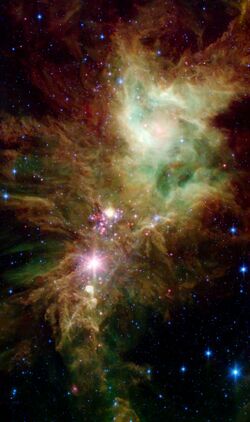Astronomy:NGC 2264
| Diffuse nebula | |
|---|---|
 | |
| Observation data: J2000.0 epoch | |
| Subtype | emission nebula |
| Right ascension | 6h 41m[1] |
| Declination | +9° 53′[1] |
| Distance | 2350 ± 52 ly (719 ± 16[2] pc) |
| Apparent magnitude (V) | 3.9[1] |
| Apparent dimensions (V) | 20′ |
| Constellation | Monoceros |
| Designations | NGC 2264, Cr 112 |
NGC 2264 is the designation number of the New General Catalogue that identifies two astronomical objects as a single object: the Cone Nebula, and the Christmas Tree Cluster. Two other objects are within this designation but not officially included, the Snowflake Cluster,[3][4] and the Fox Fur Nebula.[5] All of the objects are located in the Monoceros constellation and are located about 720 parsecs or 2,300 light-years from Earth.[2] Due to its relative proximity and large size, it is extremely well studied.[6] NGC 2264 is sometimes referred to as the Christmas Tree Cluster and the Cone Nebula. However, the designation of NGC 2264 in the New General Catalogue refers to both objects and not the cluster alone.[7] In December 2023, NASA released Christmas holiday-related images by the James Webb Space Telescope, including the Christmas Tree Galaxy Cluster and others.[8]
Structure

NGC 2264 is the location where the Cone Nebula, the Stellar Snowflake Cluster and the Christmas Tree Cluster have formed in this emission nebula. For reference, the Stellar Snowflake Cluster is located 2,700 light years away in the constellation Monoceros.
The Snowflake Cluster was granted its name due to its unmistakable pinwheel-like shape and its assortment of bright colors. The Christmas Tree star formation consists of young stars obscured by heavy layers of dust clouds. These dust clouds, along with hydrogen and helium are producing luminous new stars. The combination of dense clouds and an array of colors creates a color map filled with varying wavelengths. As seen in the photographs taken by the Spitzer Space telescope, we are able to differentiate between young red stars and older blue stars.
With varying youthful stars comes vast changes to the overall structure of the clusters and nebula. For a cluster to be considered a Snowflake, it must remain in the original location the star was formed.
When referring to this emission nebula overall, there are several aspects that contribute to the prominent configuration of a snowflake and/or Christmas tree cluster. There is a diverse arrangement of brilliant colors, and an evolving process of structure that follow star formation in a nebula.
The ratio of brown dwarfs to stars is between 1 to 2.5 and 1 to 7.5.[6]
References
- ↑ 1.0 1.1 1.2 "NGC 2264". SIMBAD. Centre de données astronomiques de Strasbourg. http://simbad.u-strasbg.fr/simbad/sim-basic?Ident=NGC+2264.
- ↑ 2.0 2.1 Maíz Apellániz, J. (2019). "Gaia DR2 distances to Collinder 419 and NGC 2264 and new astrometric orbits for HD 193 322 Aa,Ab and 15 Mon Aa,Ab". Astronomy & Astrophysics 630: A119. doi:10.1051/0004-6361/201935885. Bibcode: 2019A&A...630A.119M.
- ↑ Image sig05-028
- ↑ "Tom’s Astronomy Blog » Blog Archive » The Christmas Tree Cluster". http://tomsastroblog.com/?p=530.
- ↑ Nemiroff, R.; Bonnell, J., eds (1 July 2002). "The Fox Fur Nebula". Astronomy Picture of the Day. NASA. https://apod.nasa.gov/apod/ap020701.html.
- ↑ 6.0 6.1 Pearson, Samuel; Scholz, Aleks; Teixeira, Paula S.; Mužić, Koraljka; Almendros-Abad, Víctor (2021). "The first spectroscopically confirmed brown dwarfs in NGC 2264". Monthly Notices of the Royal Astronomical Society 507 (3): 4074–4085. doi:10.1093/mnras/stab2394.
- ↑ Seligman, Courtney. "New General Catalogue objects: NGC 2250 - 2299". http://cseligman.com/text/atlas/ngc22a.htm#2264. Retrieved 2021-09-09.
- ↑ Miller, Katrina (19 December 2023). "It’s Christmastime in the Cosmos - Astronomers have a long tradition of finding holiday cheer in outer space.". The New York Times. Archived from the original on 19 December 2023. https://archive.today/20231219114751/https://www.nytimes.com/2023/12/19/science/christmas-stars-galaxies-webb-nasa.html. Retrieved 19 December 2023.
External links
- NGC 2264 @ SEDS NGC objects pages
- NGC 2264 on WikiSky: DSS2, SDSS, GALEX, IRAS, Hydrogen α, X-Ray, Astrophoto, Sky Map, Articles and images
- Coordinates:
 06h 41m 00s, +09° 53′ 00″
06h 41m 00s, +09° 53′ 00″ - "Stars | Science Mission Directorate" (in en). https://science.nasa.gov/astrophysics/focus-areas/how-do-stars-form-and-evolve.
- O Tannenbaum, O Tannenbaum! - Astronomy Sketch of the Day, 12-25-2008
- Stellar Snowflake Cluster
- Spitzer Spots Stellar Snowflake on the 'Christmas Tree Cluster'
- The Fox Fur Nebula
- APOD: 2015 December 30 - The Fox Fur Nebula
- NASA Astronomy Picture of the Day: The Fox Fur Nebula (22 April 2008)
- NASA Astronomy Picture of the Day: The Fox Fur Nebula (14 March 2005)
- NASA Astronomy Picture of the Day: The Fox Fur Nebula (1 July 2002)
- The Fox Fur Nebula
- Best of AOP: The Fox Fur Nebula
- APOD: 14 marca 2005 - The Fox Fur Nebula
- Cone and Fox Fur Nebula Region
- Fox Fur Nebula Photo
Coordinates: ![]() 06h 41m 00s, +09° 53′ 00″
06h 41m 00s, +09° 53′ 00″
 |

